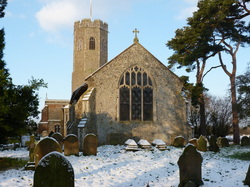St Andrews Church, Ilketshall St Andrew

Hundred River and Wainford Benefice
hundredriverbenefice.org.uk
Rector The Revd Canon Paul Nelson
01502 575859
[email protected]
Wardens: Rosemary Andrews 01986 781380
Cynthia Parry 01986 781637
Church Services
2nd & 4th Sunday in the month at 11am
details of all other services will be found on the church notice board.
Weddings Baptisms and Funerals by arrangement with the Rector
hundredriverbenefice.org.uk
Rector The Revd Canon Paul Nelson
01502 575859
[email protected]
Wardens: Rosemary Andrews 01986 781380
Cynthia Parry 01986 781637
Church Services
2nd & 4th Sunday in the month at 11am
details of all other services will be found on the church notice board.
Weddings Baptisms and Funerals by arrangement with the Rector
Your browser does not support viewing this document. Click here to download the document.
St Andrews Church, Ilketshall St Andrew
The Church is a structure of considerable antiquity, and comprises a nave and chancel only: the former is covered with a fine oak roof, but the latter is sadly disfigured by sundry rods of iron, which have been stretched across it to prevent the further spread of its walls. The walls of the nave batter internally in a very remarkable degree, thereby producing an unpleasant effect, and impressing the unpractised eye with an idea of insecurity. The nave has two doorways in the circular or Norman style, and that on the south side is richly ornamented with the zigzag, or chevron moulding.
The tower is remarkably lofty, and, standing on an elevated site, commands extensive views over the nighbourhood: it is circular, with narrow pointed windows, and crowned with an octagonal incumbent. Against the south wall of the chancel is a fine inarched surbased monument, which is, probably, the founder's tomb. The pinnacles, and moulding of its ogee arch, are terminated with bold and well-wrought finials, barbarously clogged with lime wash. The font is octangular, with eight plain shields. In 1810 there was a screen between the body of the church and the chancel, which is now destroyed. The royal arms were placed over the centre compartment, and the armorial ensigns of the Howards stood on each side; the dexter shield having these charges—1. Howard. 2. Brotherton.3. Warren. 4. Mowbray. 5. Fitzalan. 6. Cloun, arg. a chief az. 7. Maltravers.8. Widville, arg. a fess and a chief az. These shields have been placed against the wall of the nave by the Rev. F. Barkway, the present Curate.
Monuments.—"Under this stone lieth the body of John Verdon, Gent., which was forsaken of the soule the 28th day of May, 1624, but expectes it againe at ye day of the resurrection."
"Thomas Elfe, of St. Andrew's, died Oct. 23, 1705, æt. 84." Elfe bears . . . . ona fess . . . . between 3 crescents . . . . as many escallop-shells . . . . .
From: 'Ilketshall', The History and Antiquities of the County of Suffolk: volume 1 (1846), pp. 111-118. URL: http://www.british-history.ac.uk/report.aspx?compid=75121 Date accessed: 19 February 2013.
The tower is remarkably lofty, and, standing on an elevated site, commands extensive views over the nighbourhood: it is circular, with narrow pointed windows, and crowned with an octagonal incumbent. Against the south wall of the chancel is a fine inarched surbased monument, which is, probably, the founder's tomb. The pinnacles, and moulding of its ogee arch, are terminated with bold and well-wrought finials, barbarously clogged with lime wash. The font is octangular, with eight plain shields. In 1810 there was a screen between the body of the church and the chancel, which is now destroyed. The royal arms were placed over the centre compartment, and the armorial ensigns of the Howards stood on each side; the dexter shield having these charges—1. Howard. 2. Brotherton.3. Warren. 4. Mowbray. 5. Fitzalan. 6. Cloun, arg. a chief az. 7. Maltravers.8. Widville, arg. a fess and a chief az. These shields have been placed against the wall of the nave by the Rev. F. Barkway, the present Curate.
Monuments.—"Under this stone lieth the body of John Verdon, Gent., which was forsaken of the soule the 28th day of May, 1624, but expectes it againe at ye day of the resurrection."
"Thomas Elfe, of St. Andrew's, died Oct. 23, 1705, æt. 84." Elfe bears . . . . ona fess . . . . between 3 crescents . . . . as many escallop-shells . . . . .
From: 'Ilketshall', The History and Antiquities of the County of Suffolk: volume 1 (1846), pp. 111-118. URL: http://www.british-history.ac.uk/report.aspx?compid=75121 Date accessed: 19 February 2013.


